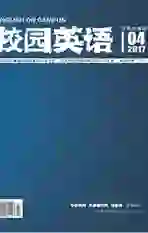Effective approaches to the teaching of reading
2017-03-20YuanXuefeng
Yuan+Xuefeng
Reading is one of the essential skills in ones life. No one could function well in modern society without this ability. However, some people still have difficulties to master this ability. The skills are even significant when someone using second or foreign language to read which is considered as the only accessible exposure to the target language (Celce-Murcia & Ohlstain, 2000). It is essential for teachers to help them cultivate good reading skills. However, Language teachers who want to keep up-to-date with the development within the teaching field are confronting with various approaches. This paper aims to demonstrates two effective teaching approaches.
Interactive approach
Teachers acknowledge that top-down and bottom-up approaches are essential for teaching reading. However, for L2 students, separate use of these two skills may cause some problems for them. L2 students may not have sufficient linguistic knowledge to decode texts by using bottom-up approach. At the same time, they may also lack of context knowledge of texts. For L2 a learner, top-down processing is could be compensatory one that help bottom-up is achieved (Koda, 2005). This is also supported by Nunan (2003), he suggested that teaching bottom-up skills should followed by instruction of top-down and strategic reading.
In order to become an effective reader, students need to be familiar with both bottom-up and top-down strategies. For instance, word recognition, skimming and scanning, prediction and so on. These strategies could be trained during practice of a three-phase approach. It consists of pre-reading, while-reading and post-reading. It could be considered as a procedure of one reading class. According to Scrivener (2005, p.187), schema theory could be useful during pre-reading, a teacher could use visual devices like pictures or videos, questions are related to topic or listening materials to active students linguistic , content and formal schemata to help students predict the given text. Then, within while-reading, students should read texts actively. Teachers could offer some general questions mainly about topics, main ideas or overall themes. They may need students to practice skimming. At the same time, teacher could conduct several specific questions mainly concerned with specific information in the text. This may require students to use scanning. Learners could also be trained to recognize the structures and the purpose of the author. Post-reading is considered as consolidating part of the class. Within this part, a teacher could let the students share their own knowledge with their fellow students. Reading could be taught with other skills like writing and speaking. Moreover, this part could enlarge the students schemata. In the three-phrase approach, vocabulary and grammar could be taught both in pre-reading and while-reading phrase. It should depend on the difficulty of the text.
Extensive reading
It is widely acknowledged that the grasp of vocabulary could influence reading, and the effective way to enlarge vocabulary is through extensive reading. (Celce-Murcia, 2000, Scrivener, 2005, Koda, 2005). According to Davis (1995), extensive reading is students who are given a text which they are interested in, and without pressure of testing or marks. Extensive reading could enlarge ones vocabulary; improve ones spelling and grammar. Other benefits could be improve both reading and writing skills, and cultivate reading habit. It is essential for students to be able to expose to different texts which motivated them. Additionally, it could help readers to combine rapid and accurate recognition and decoding of letters, words collocations, and other structural cues with sensible global prediction relate to text as a whole. It is helpful when readers use top-down and bottom-up processing to read a text.
In order to help students become an effective reader, teachers could provide books, newspapers, and magazines which students are interested in. Moreover, teachers could offer a class time purely for students to read. In order to make extensive reading more effectively, teacher could conduct several post-reading activities. For instance, write a book review, write down interesting expressions and even role play some stories. These activities tend to be more interactive, because the students is the center of the whole reading process which could help them improve both linguistic and cognitive ability.
From what demonstrate above, the effective teaching approaches such as top-down and bottom up approaches are considered to be the main effective approaches in teaching of reading. However, sometimes it seems less effective to them separately. At this time, the integration use of both approaches seems more effective. Additionally, develop various reading strategies (skimming and scanning), predict the given text (schemata theory), have a large recognition vocabulary (extensive reading) could help students to be an effective reader.
References:
[1]Celce-Murcia,C.&Olshtain.E.(2000).Discourse and context in language teaching:A guide for language teachers.New York: Cambridge University Press.
[2]Davis,C.(1995).ER:An expensive extravagance?ELT Journal, 49(4),329-336.
[3]Koda,K.(2005).Insights into second language reading.New York:Cambridge University Press.
[4]Nunan,D.(2003).Practical English language teaching.New York:McGraw-Hill.
[5]Scrivener,J.(2007).Learning Teaching.Heinemann.
